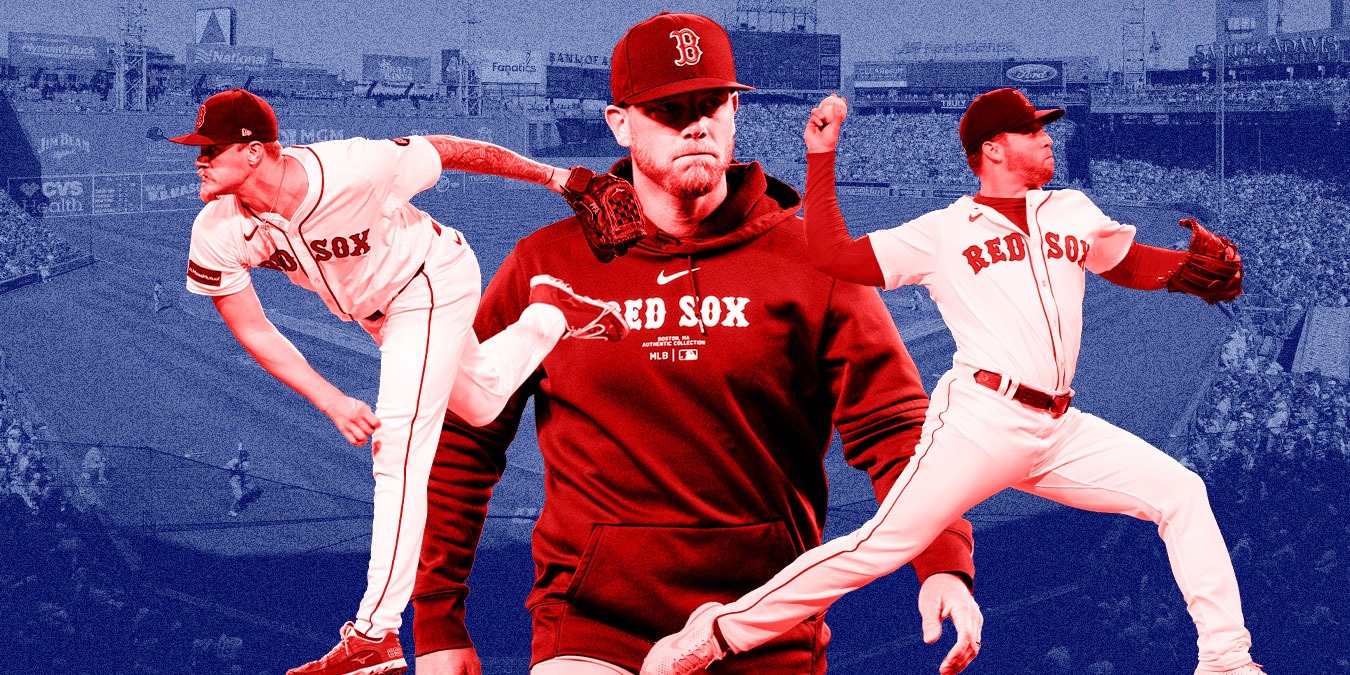More than a month into the season, the Boston Red Sox have the best team ERA in baseball thanks in large part to an unexpectedly dynamic duo atop their rotation.
Kutter Crawford and Tanner Houck are sporting two of the top 10 ERA marks among qualified pitchers, and the two very best home run prevention numbers. They are also two of the starters least likely to throw a conventional fastball at any given moment.
A new front office led by former Boston pitcher Craig Breslow has installed a new pitching coach, Andrew Bailey, and a new twist on the evolving philosophy of big-league pitching. In the opening days of the season, the Red Sox rotation rolled out starter after starter – including Crawford and Houck – who all seemed to have made an identical jarring change: Fewer fastballs.
It’s true that the Red Sox, who rank fifth in the majors in starters raw value-, have used a smaller percentage of their pitches on four-seams and two-seams than any other team this season. But the idea behind that shift is more nuanced than simply throwing fewer fastballs.
What the Red Sox are doing is less about cutting back on heaters and more about reconsidering the longstanding orthodoxy of what counts as a “primary” pitch and when pitchers need to throw one.
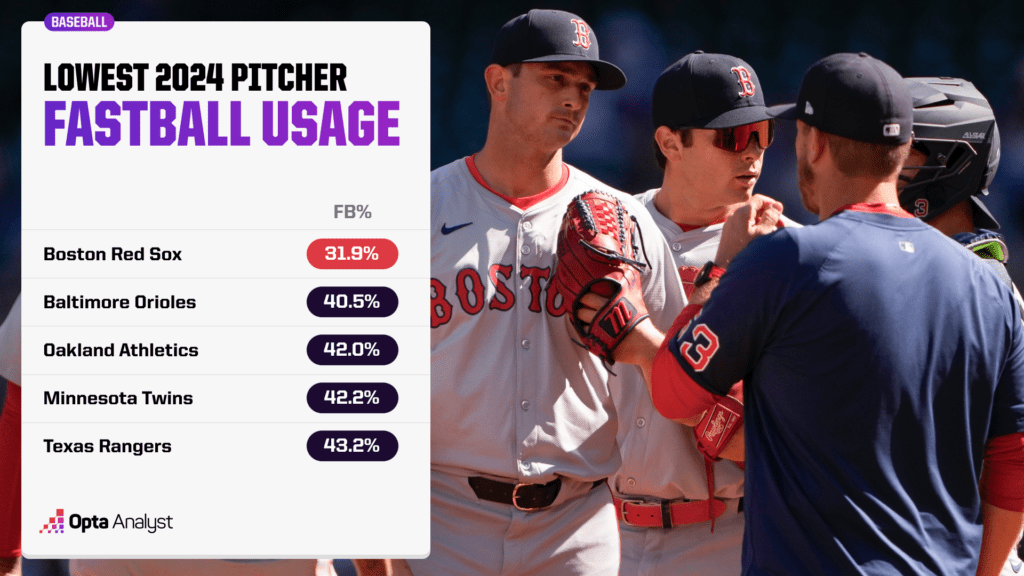
If Crawford and Houck continue to surf atop the leaderboards into the summer, or into American League Cy Young contention, you’ll almost certainly notice more and more pitchers begin to have similar thoughts.
Let’s take a look at exactly how the Red Sox are, and aren’t, using fastballs.
Maybe it’s appropriate that the rise of PitchCom coincided with the decline of the fastball in MLB. For most of baseball history, the fastball’s unquestioned supremacy was encapsulated by its typical standing in a catcher’s signals: No. 1, one finger down.
It was not that long ago that the broad categories of “fastballs” and “secondary” offerings made literal sense. More than 55% of all pitches thrown in the big leagues were fastballs as recently as 2017.
That has been in sharp decline in recent years, though, with bendy pitches such as sliders making up ground most quickly, and offspeed pitches such as changeups rising especially noticeably this year.
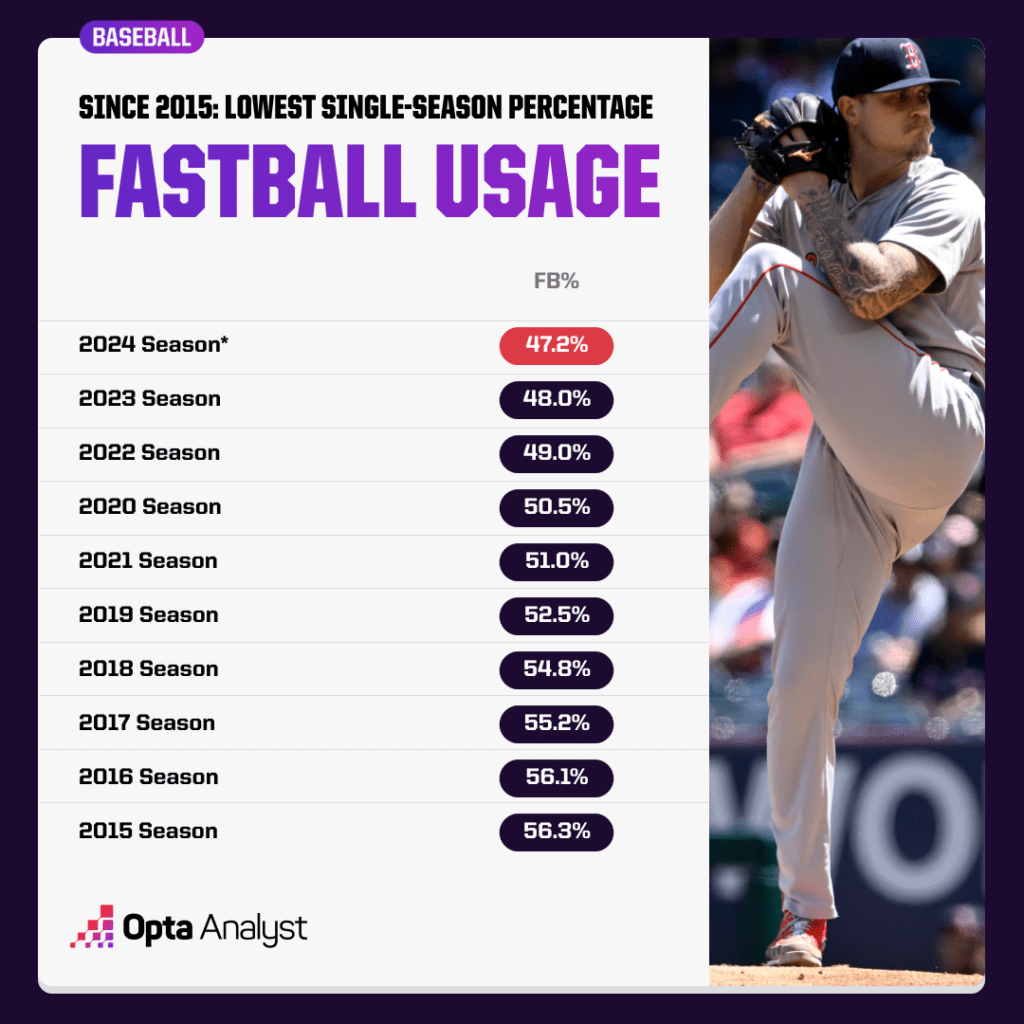
So while the Red Sox are not breaking the mold by relegating the heater to a lesser stature in their arsenals, they do seem to be reimagining the fastball’s purpose. Bailey, the pitching coach who came over from the San Francisco Giants, told The Athletic in April that he has asked his pitchers to consider the best ways to leverage all their pitches, not just default to a fastball because it is a “fastball count.”
“I think the history of baseball suggests that when you’re in disadvantaged counts, your best strike pitch is a fastball from an ability standpoint and I don’t think that’s true,” Bailey said.
In a way, this is just unleashing abilities their young pitchers likely already had by virtue of coming up in the age of pitch design.
Early lessons from Statcast, which started rendering public data in 2015, led to a rush of high-spin four-seam fastballs thrown high in the zone to miss bats and get pop-ups. That worked great for Justin Verlander and Gerrit Cole. It still works well for a great many pitchers, including promising young arms such as Joe Ryan and Bryce Miller.
More data and more experience, however, has proven it’s not for everyone. The landscape has rightfully become more nuanced. The pitchers who have amazing four-seam fastballs can and should use them at will, but another huge swath of hurlers have found that different, diversified approaches produce better results.
That manifests in a couple ways. One way is the rise of what has usually been called “pitching backwards” or leading with breaking or offspeed pitches instead of a fastball. Another way, though, is diversified fastball usage. You don’t have to have Corbin Burnes’ devastating cutter to reap benefits from a high-velocity pitch that zips a little to the glove side. In true cyclical baseball fashion, it’s no longer passé to use a sinker to grab some ground-ball contact.
Opta data shows that in 2021, 84% of pitchers (min. 20 starts) were using a traditional (four-seam or sinker) fastball as their primary, or most-used, pitch. In 2024, that number is down to 77% (who have made at least five starts), still the vast majority, but sinking.
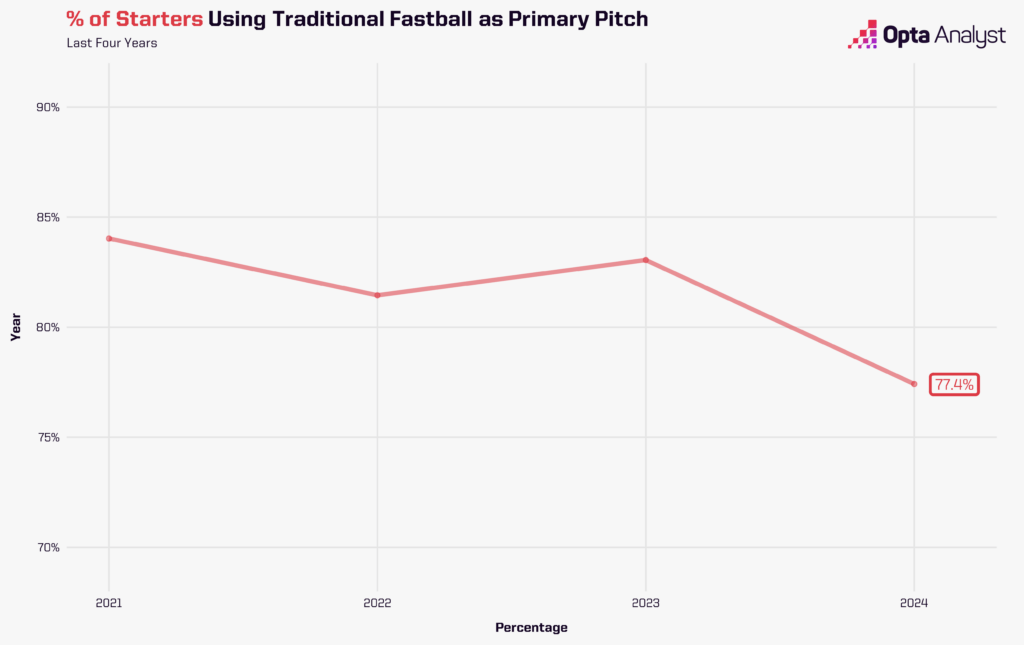
The magnitude of the primary offering in an arsenal is also waning. Among all pitch types, Opta data shows that those starters’ most-used option is, on average, deployed 40% of the time in 2024, down from 42% in 2021.
Perhaps more striking: In 2021, only 19% of those starters used their primary pitch less than a third of the time. In 2024, 27% of starters have widened their usage patterns to that point.
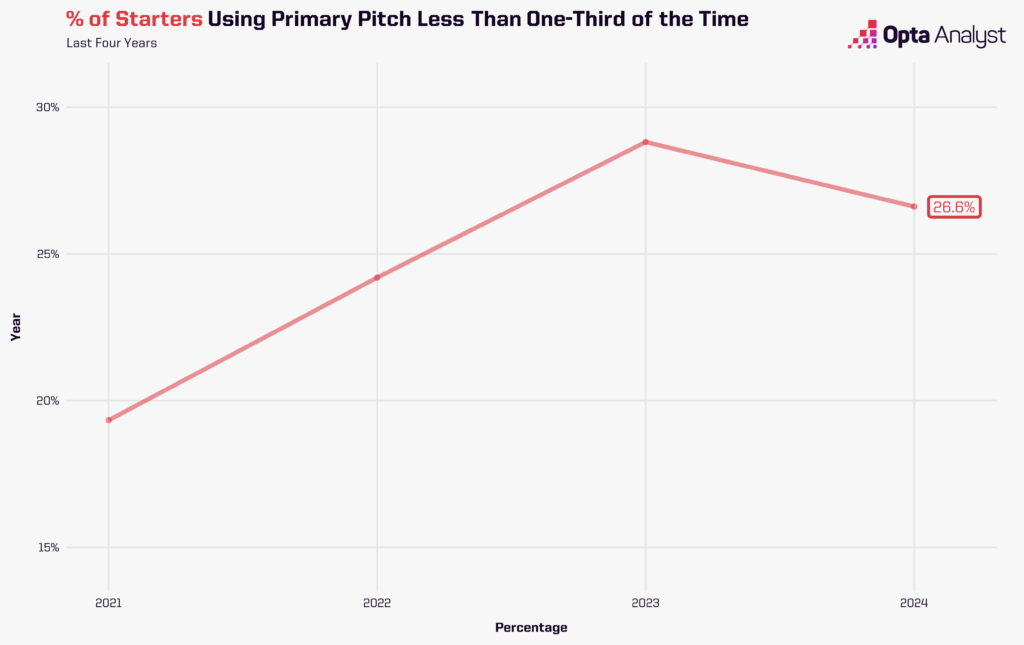
In the grand scheme, the Red Sox rotation doesn’t look revolutionary so much as a series of isolated cases that illustrate just how individualized pitching strategy can and should be.
Crawford fits in the diversification bucket, a member of that expanding class of pitchers who don’t use any of their pitches even a third of the time. And Houck fits in the “backwards” category, using a “secondary” pitch as their primary weapon.
If they weren’t experiencing parallel breakouts on the same team, Crawford and Houck wouldn’t invoke many comparisons. Crawford (below) employs a particularly staccato version of the truncated arm action most associated with injured teammate Lucas Giolito. Houck throws like a less gangly mirror image of Chris Sale.
Both, however, are thriving by loosening the reins of pitching convention.
Crawford, a relatively unheralded 28-year-old right-hander, only secured a rotation spot last season. Yet today, he’s second among qualifiers with a sparkling 1.56 ERA and 10th in MLB with a 70 raw value- (RV-), which is an overall pitching metric where 100 is league average and 70 means he’s been 30% better than average.
The big change this year involves cutting his four-seam fastball down from its place atop his arsenal (39.1% in 2023) and putting it in a tandem situation with his cutter. He now throws the cutter on 32.4% of pitches and the four-seam 29.3% of pitches. He has also bought into and elevated a sweeper that he is using 24.3% of the time in 2024 after having it as one of a menagerie of offspeed offerings last year.
Contrary to what you might glean from lowering its usage, Crawford doesn’t have a bad four-seam fastball. It tallied a terrific 43 RV- in 2023 and has a 54 RV- in 2024. But Crawford’s average command (101 in command+ on four-seamers in 2023) often forced him into situations where he became predictable, and in turn chose between two bad options: piping a fastball into the heart of the zone or skirting it and handing out free passes.
When behind in the count in 2023, he almost always went to either the cutter or the four-seam, allowing hitters to train their vision on a far more limited range of movement. Now, he is using the sweeper just about as often in those risky counts as in any other count, and per our command+ numbers, he actually shows a better knack for locating that dramatic breaking pitch than for any of his other options.
In tough spots, he can whip out that sweeper to befuddle batters sitting on something more direct.
That new wrinkle helping him escape dicey situations would be plenty, but the shift is also boosting the effectiveness of his fastball duo, with the cutter and the sweeper operating out of the same tunnel. Even leaning on it more, Crawford is getting a better RV- on his cutter (50 in 2024 vs. 62 in 2023) by throwing it for more strikes.
Houck, the 27-year-old righty, was already throwing his terrific slider more than any other offering before Bailey showed up but has now dispensed with a perfunctory four-seam fastball entirely and cut back on his cutter, leaning into a narrower arsenal optimized for his low, side-slinging arm angle. For the most part, Houck is now slider, sinker and splitter, along with the sparsely used cutter he sometimes deploys against lefties.
So far, so good. His 1.99 ERA ranks 10th among qualified starters, and his 77 RV- ranks 21st.
The splitter comes with the biggest delta from 2023. If there’s a truly newfangled idea in here, it’s the notion that a starter could clear out the space where a trusty, straight four-seam fastball used to be and replace it with the daring dive of a splitter, a pitch that only recently emerged from decades in the shadows.
But as unconventional as it might be on a grand scale, it’s a very reasonable solution when your scope is limited to the task at hand: Making Houck’s arsenal work better for him. Houck’s old four-seam was neither good nor useful. In 2023, it logged a 142 RV- and was the only pitch with which he didn’t display above-average command (98 command+), while his other fastball, the sinker, is a far better dance partner with his slider’s horizontal movement.
In carving out that four-seam space and doubling his splitter usage, from 11% in 2023 to 22.5% in 2024, Houck has shown a willingness to throw the offspeed pitch for a strike, and when behind in the count.
As a result, his splitter rates as the 13th most valuable in the game in terms of total accumulated RV (minus-1.4), ahead of Yoshinobu Yamamoto and Zack Littell. But it stands apart in that it isn’t simply a two-strike whiff machine. Houck’s 94 whiff+ on his splitter is rare in this range of the leaderboard, but he’s throwing it where he intends to (a 115 command+) and getting lots of weak contact that pumps up his 51 BIP- (measures damage done upon contact) to outsized importance.
With something so different potentially coming out of his hand, hitters have struggled even more against Houck’s whirlwind slider; he’s now sporting an elite 32 RV- on the pitch.
Hitters now have a much more challenging calculation. What pitch can they sit on?
Sound familiar? They will have to continue to modulate their approaches as the league sees them and adjusts, but both Crawford and Houck have settled into a groove that suits their specific styles.
What Bailey asked his pitchers in Boston to do was follow the logic of their own strengths and weaknesses. That it led them to the top of the results leaderboards, at least for now, was by design. That it led them to the bottom of the fastball usage leaderboards was mostly happenstance.
The philosophy isn’t anti-fastball. It’s just anti-fastball-for-fastball’s-sake.
Research support provided by Stats Perform’s Quinton Bonnell and Brady Olson. Check out our MLB, NBA and NFL coverage. Follow us on X and Instagram for more!
